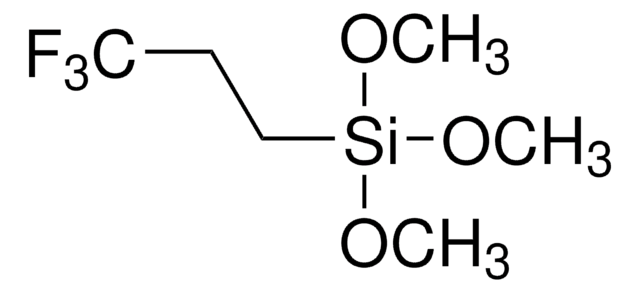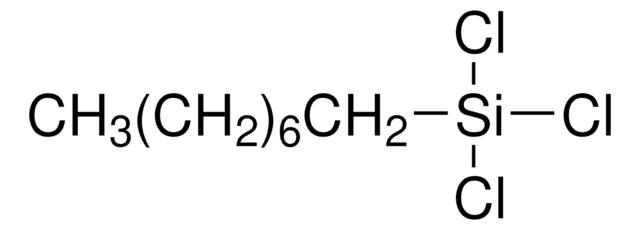667420
1H,1H,2H,2H-Perfluorooctyltriethoxysilane
98%
Sinonimo/i:
Triethoxy(1H,1H,2H,2H-perfluoro-1-octyl)silane, Triethoxy(3,3,4,4,5,5,6,6,7,7,8,8,8-tridecafluoro-1-octyl)silane
About This Item
Prodotti consigliati
Livello qualitativo
Saggio
98%
Indice di rifrazione
n20/D 1.344
Densità
1.3299 g/mL at 25 °C
Stringa SMILE
CCO[Si](CCC(F)(F)C(F)(F)C(F)(F)C(F)(F)C(F)(F)C(F)(F)F)(OCC)OCC
InChI
1S/C14H19F13O3Si/c1-4-28-31(29-5-2,30-6-3)8-7-9(15,16)10(17,18)11(19,20)12(21,22)13(23,24)14(25,26)27/h4-8H2,1-3H3
AVYKQOAMZCAHRG-UHFFFAOYSA-N
Cerchi prodotti simili? Visita Guida al confronto tra prodotti
Descrizione generale
Applicazioni
Avvertenze
Warning
Indicazioni di pericolo
Consigli di prudenza
Classi di pericolo
Aquatic Chronic 4 - Eye Irrit. 2 - Skin Irrit. 2 - STOT SE 3
Organi bersaglio
Respiratory system
Codice della classe di stoccaggio
10 - Combustible liquids
Classe di pericolosità dell'acqua (WGK)
WGK 1
Dispositivi di protezione individuale
Eyeshields, Gloves, type ABEK (EN14387) respirator filter
Scegli una delle versioni più recenti:
Possiedi già questo prodotto?
I documenti relativi ai prodotti acquistati recentemente sono disponibili nell’Archivio dei documenti.
I clienti hanno visto anche
Articoli
Inorganic nanomaterials are tunable by size, shape, structure, and/or composition. Advances in the synthesis of well-defined nanomaterials have enabled control over their unique optical, electronic, and chemical properties stimulating tremendous interest across a wide range of disciplines. This article illuminates some of the recent research advances of inorganic nanoparticles (NPs) in optoelectronics applications.
Il team dei nostri ricercatori vanta grande esperienza in tutte le aree della ricerca quali Life Science, scienza dei materiali, sintesi chimica, cromatografia, discipline analitiche, ecc..
Contatta l'Assistenza Tecnica.











